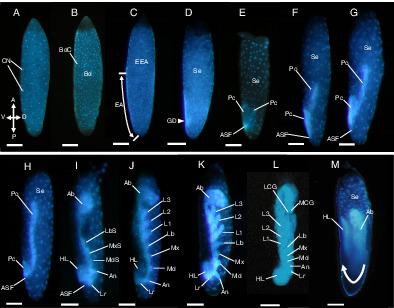当前位置:
X-MOL 学术
›
Entomol. Sci.
›
论文详情
Our official English website, www.x-mol.net, welcomes your
feedback! (Note: you will need to create a separate account there.)
Embryogenesis of the damselfly Euphaea yayeyamana Oguma (Insecta: Odonata: Euphaeidae), with special reference to the formation of their larval abdominal “gill‐like” appendages
Entomological Science ( IF 0.7 ) Pub Date : 2020-06-11 , DOI: 10.1111/ens.12421 Kohei Suzuki 1 , Yoko Watanabe 2 , Koji Tojo 1, 3
Entomological Science ( IF 0.7 ) Pub Date : 2020-06-11 , DOI: 10.1111/ens.12421 Kohei Suzuki 1 , Yoko Watanabe 2 , Koji Tojo 1, 3
Affiliation

|
The acquisition of wings in insects is the most significant subject in considering the diversification and adaptive radiation of insects, that is, the “macro‐evolution” of insects. In the discussion of the origin of insect wings, Palaeoptera has attracted particular attention in phylogenetic and evolutionary studies. In particular, Ephemeroptera have segmental gill‐structures on their abdominal segments during their nymphal stage, and these have been noted in discussions regarding their homology and/or serial homology between wings, gills and appendages. Although Odonata has received little attention in the course of these discussions, there are cases of segmental gill‐like structures on their abdomen in the two families, Euphaeidae and Polythoridae. Under such cirumstances, in this study, the embryological developmental process in Euphaea yayeyamana of Euphaeidae was observed, focusing on the formation process of the gill‐like structures. As a result, it was revealed that four of the seven pairs of gill‐like projection structures started their visible formation within the middle stages of embryonic development, and the remaining three pairs developed during the early stages of post‐embryogenesis. Some joint‐like structures existed in all of the gill‐like projections. It was revealed that muscle tissue was interposed within these protrusions and that all of the projections themselves fully articulated, and that the nervous system was extended into the protrusions. All of the gill‐like projections strongly suggested their homology with the cephalic and thoracic appendages, when we considered them with regard to their serial homology based on the topology of their formation position.
中文翻译:

豆娘 Euphaea yayeyamana Oguma(昆虫纲:Odonata:Euphaeidae)的胚胎发生,特别是关于它们幼虫腹部“鳃状”附属物的形成
昆虫翅膀的获得是考虑昆虫多样化和适应性辐射的最重要课题,即昆虫的“宏观进化”。在昆虫翅膀起源的讨论中,古翅目在系统发育和进化研究中引起了特别的关注。特别是,蜉蝣在其若虫阶段的腹节上有节段鳃结构,这些在关于它们的同源性和/或翅膀、鳃和附属物之间的序列同源性的讨论中已经被注意到。虽然在这些讨论过程中,蜻蜓目很少受到关注,但在蜻蜓科和虎蛛科这两个科中,它们的腹部都有节段鳃状结构的例子。在这种情况下,在本研究中,观察了Euphaeidae Euphaea yayeyamana的胚胎发育过程,重点研究了鳃状结构的形成过程。结果表明,七对鳃状突起结构中有四对在胚胎发育的中期开始形成,其余三对在胚胎发生后的早期阶段发育。在所有鳃状突起中都存在一些关节状结构。结果表明,这些突起中插入了肌肉组织,并且所有突起本身都完全铰接,并且神经系统延伸到突起中。所有的鳃状突起都强烈表明它们与头和胸的附属物具有同源性,
更新日期:2020-06-11
中文翻译:

豆娘 Euphaea yayeyamana Oguma(昆虫纲:Odonata:Euphaeidae)的胚胎发生,特别是关于它们幼虫腹部“鳃状”附属物的形成
昆虫翅膀的获得是考虑昆虫多样化和适应性辐射的最重要课题,即昆虫的“宏观进化”。在昆虫翅膀起源的讨论中,古翅目在系统发育和进化研究中引起了特别的关注。特别是,蜉蝣在其若虫阶段的腹节上有节段鳃结构,这些在关于它们的同源性和/或翅膀、鳃和附属物之间的序列同源性的讨论中已经被注意到。虽然在这些讨论过程中,蜻蜓目很少受到关注,但在蜻蜓科和虎蛛科这两个科中,它们的腹部都有节段鳃状结构的例子。在这种情况下,在本研究中,观察了Euphaeidae Euphaea yayeyamana的胚胎发育过程,重点研究了鳃状结构的形成过程。结果表明,七对鳃状突起结构中有四对在胚胎发育的中期开始形成,其余三对在胚胎发生后的早期阶段发育。在所有鳃状突起中都存在一些关节状结构。结果表明,这些突起中插入了肌肉组织,并且所有突起本身都完全铰接,并且神经系统延伸到突起中。所有的鳃状突起都强烈表明它们与头和胸的附属物具有同源性,











































 京公网安备 11010802027423号
京公网安备 11010802027423号